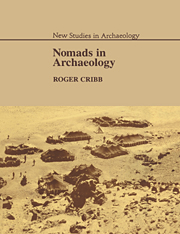Book contents
- Frontmatter
- Contents
- List of illustrations
- List of tables
- Preface
- 1 Introduction
- 2 Origins and definitions
- 3 Nomad pastoral economy
- 4 Residence, descent and territory
- 5 Nomads – the invisible culture?
- 6 Nomad architecture and domestic space
- 7 Ali's camp: a nomad household campsite
- 8 The structure and location of nomad settlements
- 9 Sariaydin Yayla
- 10 The lost world of Nemrut Daḡ
- 11 Nomad archaeology: an assessment
- 12 Towards a model of unstable settlement systems
- References
- Glossary
- Index
11 - Nomad archaeology: an assessment
Published online by Cambridge University Press: 23 September 2009
- Frontmatter
- Contents
- List of illustrations
- List of tables
- Preface
- 1 Introduction
- 2 Origins and definitions
- 3 Nomad pastoral economy
- 4 Residence, descent and territory
- 5 Nomads – the invisible culture?
- 6 Nomad architecture and domestic space
- 7 Ali's camp: a nomad household campsite
- 8 The structure and location of nomad settlements
- 9 Sariaydin Yayla
- 10 The lost world of Nemrut Daḡ
- 11 Nomad archaeology: an assessment
- 12 Towards a model of unstable settlement systems
- References
- Glossary
- Index
Summary
This study has been built around the proposition that nomadic sites constitute an analytically distinct settlement category requiring different methods of survey, recording and excavation from those commonly employed by archaeological fieldworkers in the Near East. Having arrived at an understanding not only of the structure, location and contents of nomad campsites, but also the kinds of methodological and theoretical problems that are best pursued in relation to this kind of site, let us now reconsider what archaeological evidence is available.
Tepe Tula'i
It is significant that the only site securely identified as a nomadic – or at least pastoral – campsite was detected not through intentional survey but in the course of rescue operations on a small Sassanian site prior to an agricultural development scheme in Khuzistan (Hole 1974–75, 1975). Tepe Tula'i lies near the northern edge of the Khuzistan Plain about 4 kilometres east of the Karkheh River and 17 kilometres west of Dezful, placing it on a possible seasonal migration route from Khuzistan to summer pastures around Khorammabad in the Zagros Mountains.
The site first appeared as a low mound dissected by old irrigation canals, the surface of which was covered by loose, rocky fill containing Sassanian sherds. These were partially mixed with prehistoric sherds from a layer of hard-packed fill, disturbed by burrows, which extended well beyond the confines of the mound itself.
- Type
- Chapter
- Information
- Nomads in Archaeology , pp. 212 - 224Publisher: Cambridge University PressPrint publication year: 1991

